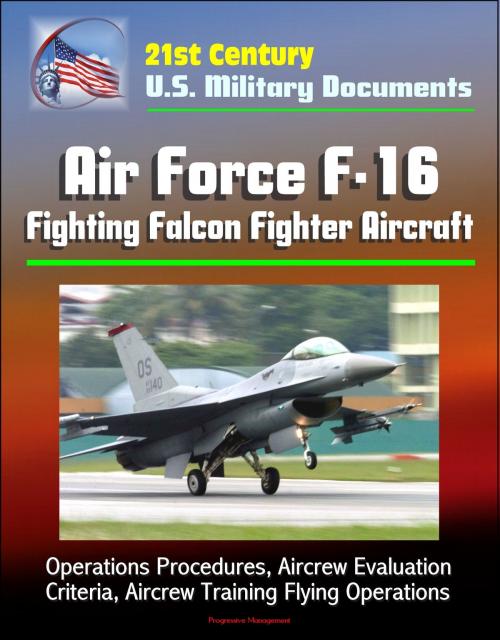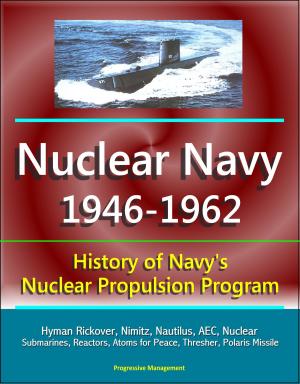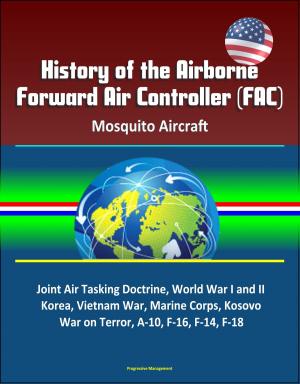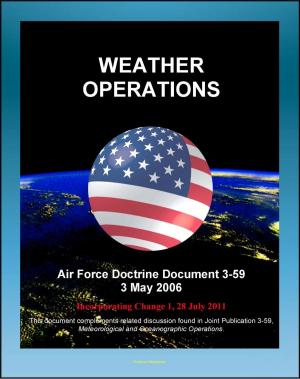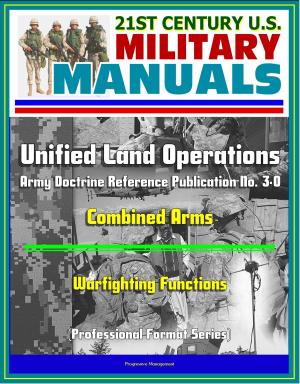21st Century U.S. Military Documents: Air Force F-16 Fighting Falcon Fighter Aircraft - Operations Procedures, Aircrew Evaluation Criteria, Aircrew Training Flying Operations
Nonfiction, Science & Nature, Technology, Aeronautics & Astronautics, History, Military, Aviation| Author: | Progressive Management | ISBN: | 9781311665263 |
| Publisher: | Progressive Management | Publication: | November 8, 2013 |
| Imprint: | Smashwords Edition | Language: | English |
| Author: | Progressive Management |
| ISBN: | 9781311665263 |
| Publisher: | Progressive Management |
| Publication: | November 8, 2013 |
| Imprint: | Smashwords Edition |
| Language: | English |
Three Air Force documents provide unique information about USAF operations of the F-16 Fighting Falcon Fighter aircraft.
Contents: Operations Procedures * Aircrew Evaluation Criteria * Aircrew Training
Chapter 1 * GENERAL GUIDANCE * 1.1. Abbreviations, Acronyms, and Terms * 1.2. Responsibilities * 1.3. Waivers * 1.4. Processing Changes * Chapter 2 * MISSION PLANNING * Section 2A—General * 2.1. Responsibilities * 2.2. Bird/Wildlife Aircraft Strike Hazard (BASH) Programs * 2.3. Standards * 2.4. CBRNE * 2.5. Flight Material Preparation * 2.6. Fuel Conservation * 2.7. Overwater * 2.8. Briefing and Debriefing * 2.9. Unit Developed Checklists/Local Pilot Aids * Section 2B—Night (see also night sections of Chapter 3, Chapter 5 and Chapter 6) * 2.10. Minimum Safe Altitude (MSA) * 2.11. Night chart requirements * 2.12. Low Altitude Navigation and Targeting Infra-Red for Night (LANTIRN) Navigation Pod Operations * Chapter 3 * NORMAL OPERATING PROCEDURES * Section 3A * Ground Operations * 3.1. Preflight * 3.2. Ground Visual Signals * 3.3. Taxi and Arming * 3.4. EOR Inspections and Before Takeoff Checks * 3.5. Flight Lineup * Section 3B—Takeoff and Departure * 3.6. Takeoff * 3.7. Initial Join-up and Rejoins * Section 3C—-Enroute * 3.8. Air Refueling * 3.9. Aircraft Handling Characteristics (AHC)/Maneuvering Parameters * 3.10. Formation, General * 3.11. G-Awareness Exercises (G-Ex) (Reference AFTTP 3-3 * 3.12. Tactical Formations * 3.13. Chase Formation * 3.14. Show Formation * 3.15. Low Altitude Operations (reference AFTTP 3-1 * Section 3D—-Recovery and Landing * 3.16. Gear Checks * 3.17. Angle of Attack (AOA) * 3.18. Landing restrictions * 3.19. Desired touchdown point and spacing * 3.20. Low Approaches * 3.21. Touch-and-Go Landings * 3.22. Overhead Traffic Patterns * 3.23. Tactical Overhead Traffic Patterns * 3.24. Closed Traffic Patterns * 3.25. Back Seat Approaches and Landings * 3.26. Formation Approaches and Landings * Section 3E—Night (see also night sections of Chapter 2, Chapter 5 and Chapter 6) * 3.27. General Night Procedures * 3.28. Operating with both Night Vision Goggles (NVG) and Terrain Following Radar (TFR) * 3.29. Night Vision Goggles (NVG) Procedures * 3.30. Terrain Following Radar (TFR) Operations at Night * Section 3F—Other * 3.31. Targeting Pod Operations * 3.32. Radio Procedures * 3.33. Lap Belts * 3.34. Change of Aircraft Control * 3.35. Fuel Requirements * 3.36. Radar Altimeters and Terrain Warning/Avoidance Systems * 3.37. Wind and Sea State Restrictions * 3.38. Identification Friend or Foe/Selective Identification Feature (IFF/SIF) * Chapter 4 * INSTRUMENT PROCEDURES * 4.1. General * 4.2. Takeoff and Initial Join-up * 4.3. Trail Procedures * 4.4. Formation Break-up * 4.5. Formation Penetration * 4.6. Formation Approach * 4.7. Instrument Approach Procedures * Chapter 5 * AIR-TO-AIR WEAPONS EMPLOYMENT * 5.1. General * 5.2. Simulated Gun Employment * 5.3. Maneuvering Limitations * Chapter 6 * AIR-TO-SURFACE WEAPONS EMPLOYMENT * Section 6A—-General * 6.1. General * 6.2. Simulated Gun Employment * 6.3. Training Missions with a Hot Gun * 6.4. Simulated Attacks against off-Range or Manned Targets * 6.5. Weather * 6.6. Pop-Up Attacks * 6.7. Target Identification * 6.8. Safety of Ground Personnel * Section 6B—-Night * 6.9. Altitude * 6.10. Bank Angle * 6.11. TFR * Chapter 7 * ABNORMAL OPERATING PROCEDURES * 7.1. General * 7.2. Critical Action Procedures (CAPs) * 7.3. Ground Aborts * 7.4. Takeoff Aborts * 7.5. Air Aborts * 7.6. Radio Failure (NORDO) * 7.7. Severe Weather Penetration * 7.8. Spatial Disorientation (SD) * 7.9. Lost Wingman * 7.10. Armament System Malfunctions * 7.11. In-flight Practice of Emergency Procedures * 7.12. Search and Rescue (SAR) Procedures * 7.13. Abnormal Operation of TFR or NAV FLIR * 7.14. Post Arresting Gear Engagement Procedures
Three Air Force documents provide unique information about USAF operations of the F-16 Fighting Falcon Fighter aircraft.
Contents: Operations Procedures * Aircrew Evaluation Criteria * Aircrew Training
Chapter 1 * GENERAL GUIDANCE * 1.1. Abbreviations, Acronyms, and Terms * 1.2. Responsibilities * 1.3. Waivers * 1.4. Processing Changes * Chapter 2 * MISSION PLANNING * Section 2A—General * 2.1. Responsibilities * 2.2. Bird/Wildlife Aircraft Strike Hazard (BASH) Programs * 2.3. Standards * 2.4. CBRNE * 2.5. Flight Material Preparation * 2.6. Fuel Conservation * 2.7. Overwater * 2.8. Briefing and Debriefing * 2.9. Unit Developed Checklists/Local Pilot Aids * Section 2B—Night (see also night sections of Chapter 3, Chapter 5 and Chapter 6) * 2.10. Minimum Safe Altitude (MSA) * 2.11. Night chart requirements * 2.12. Low Altitude Navigation and Targeting Infra-Red for Night (LANTIRN) Navigation Pod Operations * Chapter 3 * NORMAL OPERATING PROCEDURES * Section 3A * Ground Operations * 3.1. Preflight * 3.2. Ground Visual Signals * 3.3. Taxi and Arming * 3.4. EOR Inspections and Before Takeoff Checks * 3.5. Flight Lineup * Section 3B—Takeoff and Departure * 3.6. Takeoff * 3.7. Initial Join-up and Rejoins * Section 3C—-Enroute * 3.8. Air Refueling * 3.9. Aircraft Handling Characteristics (AHC)/Maneuvering Parameters * 3.10. Formation, General * 3.11. G-Awareness Exercises (G-Ex) (Reference AFTTP 3-3 * 3.12. Tactical Formations * 3.13. Chase Formation * 3.14. Show Formation * 3.15. Low Altitude Operations (reference AFTTP 3-1 * Section 3D—-Recovery and Landing * 3.16. Gear Checks * 3.17. Angle of Attack (AOA) * 3.18. Landing restrictions * 3.19. Desired touchdown point and spacing * 3.20. Low Approaches * 3.21. Touch-and-Go Landings * 3.22. Overhead Traffic Patterns * 3.23. Tactical Overhead Traffic Patterns * 3.24. Closed Traffic Patterns * 3.25. Back Seat Approaches and Landings * 3.26. Formation Approaches and Landings * Section 3E—Night (see also night sections of Chapter 2, Chapter 5 and Chapter 6) * 3.27. General Night Procedures * 3.28. Operating with both Night Vision Goggles (NVG) and Terrain Following Radar (TFR) * 3.29. Night Vision Goggles (NVG) Procedures * 3.30. Terrain Following Radar (TFR) Operations at Night * Section 3F—Other * 3.31. Targeting Pod Operations * 3.32. Radio Procedures * 3.33. Lap Belts * 3.34. Change of Aircraft Control * 3.35. Fuel Requirements * 3.36. Radar Altimeters and Terrain Warning/Avoidance Systems * 3.37. Wind and Sea State Restrictions * 3.38. Identification Friend or Foe/Selective Identification Feature (IFF/SIF) * Chapter 4 * INSTRUMENT PROCEDURES * 4.1. General * 4.2. Takeoff and Initial Join-up * 4.3. Trail Procedures * 4.4. Formation Break-up * 4.5. Formation Penetration * 4.6. Formation Approach * 4.7. Instrument Approach Procedures * Chapter 5 * AIR-TO-AIR WEAPONS EMPLOYMENT * 5.1. General * 5.2. Simulated Gun Employment * 5.3. Maneuvering Limitations * Chapter 6 * AIR-TO-SURFACE WEAPONS EMPLOYMENT * Section 6A—-General * 6.1. General * 6.2. Simulated Gun Employment * 6.3. Training Missions with a Hot Gun * 6.4. Simulated Attacks against off-Range or Manned Targets * 6.5. Weather * 6.6. Pop-Up Attacks * 6.7. Target Identification * 6.8. Safety of Ground Personnel * Section 6B—-Night * 6.9. Altitude * 6.10. Bank Angle * 6.11. TFR * Chapter 7 * ABNORMAL OPERATING PROCEDURES * 7.1. General * 7.2. Critical Action Procedures (CAPs) * 7.3. Ground Aborts * 7.4. Takeoff Aborts * 7.5. Air Aborts * 7.6. Radio Failure (NORDO) * 7.7. Severe Weather Penetration * 7.8. Spatial Disorientation (SD) * 7.9. Lost Wingman * 7.10. Armament System Malfunctions * 7.11. In-flight Practice of Emergency Procedures * 7.12. Search and Rescue (SAR) Procedures * 7.13. Abnormal Operation of TFR or NAV FLIR * 7.14. Post Arresting Gear Engagement Procedures
